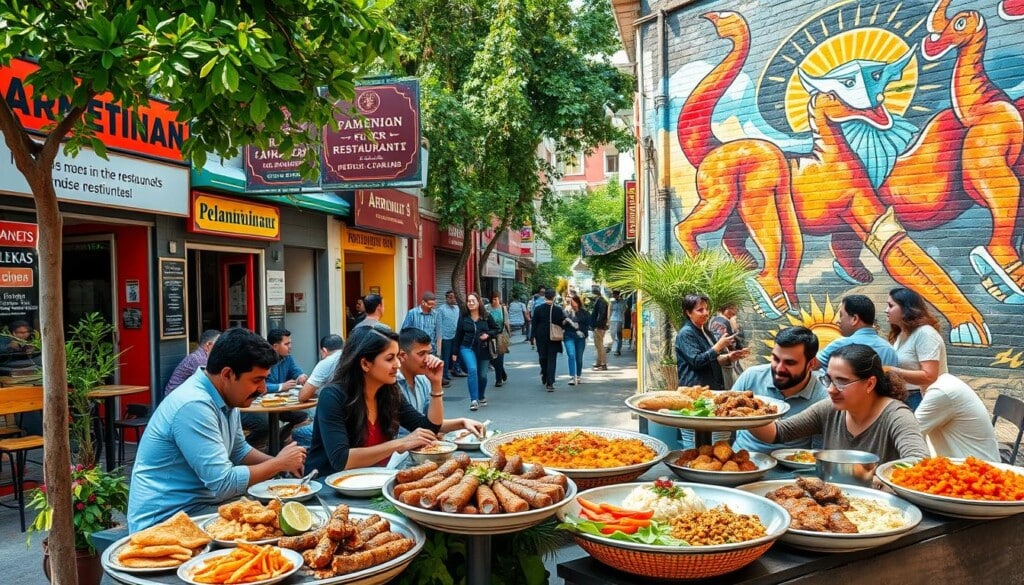What makes Armenian cuisine special in the United States? Food lovers look for the best Armenian restaurants. These places serve tasty meals and share Armenian culture. We’ll look at top Armenian dining spots in big cities, focusing on their unique tastes, health benefits, and community ties.
Finding great Armenian food restaurants is easy with LocalZ. You’ll find everything from classic dishes to new twists. Explore Armenian cuisine and find the hidden gems in your area.
Key Takeaways
- Understanding the rich heritage and tradition of Armenian cuisine.
- Identifying the best Armenian restaurants in major cities.
- Appreciating the unique ingredients that define Armenian dishes.
- Exploring the nutritional benefits associated with Armenian food.
- Leveraging online directories for local restaurant discovery.
- Engaging with local communities through culinary experiences.
The Rich Heritage of Armenian Cuisine
Traditional Armenian cuisine is deeply connected to the Armenian people’s culture and history. It combines different tastes, textures, and aromas. This is shaped by the region’s varied geography.
It shows centuries of tradition and influences from nearby cultures. So, meals in Armenia tell a story, full of heritage and flavors.
Key Ingredients in Armenian Cooking
Lamb is a key ingredient in Armenian dishes, adding a rich flavor. Eggplant is also common, used in stews and grilled dishes. It brings a unique taste to Armenian food.
Spices like coriander and sumac add to the aroma and taste of dishes. They create a special harmony in every bite.
Traditional Dishes to Try
Dolma, stuffed grape leaves, is a standout dish, showing the love put into Armenian cooking. Lule kebabs, with spiced minced meat, also showcase the heritage. These dishes not only taste great but also honor Armenian culinary history.
The Influence of Geography on Flavors
The varied landscapes of Armenia shape the flavors in traditional dishes. Different climates and farming practices lead to unique ingredients in each region. This makes Armenian cuisine a rich mix of tastes.
This diversity adds to the cultural value of each meal. It makes dining in Armenia a special experience.
Top Armenian Food Restaurants in Major US Cities
Exploring Armenian cuisine in major U.S. cities shows a rich mix of flavors and traditions. Local communities love these culinary spots, making them popular. Each city adds its own twist to Armenian food, showing both traditional and new dishes.
Los Angeles: A Hub for Armenian Cuisine
Los Angeles is known for its big Armenian community. This leads to many Armenian dining options. Places like Zhengyalov Hatz in Glendale are famous for their zhingyalov hats, made with fresh herbs in special bread.
This dish captures Armenian cooking’s essence and is good for health. The city has many top Armenian restaurants, showing both cultural and modern sides of the cuisine.
New York City: Fusion and Tradition
New York City’s food scene loves fusion, mixing Armenian flavors with others. Armenian restaurants here often blend traditional ingredients with new techniques. This attracts people looking for new tastes.
They can try modern takes on classic dishes. This makes Armenian food a big part of the city’s food culture. Top Armenian eateries in New York offer unique flavors and creativity.
Washington, D.C.: Taste of Armenia in the Capital
Washington, D.C. is a great place to try authentic Armenian food. The city has many restaurants that serve traditional dishes well. These meals connect food with heritage for everyone.
Enjoying Armenian cuisine here is like a journey through history and community. It makes dining at the best Armenian restaurants in the capital even more special.

Why Choose Armenian Food?
Armenian cuisine is not just tasty; it’s also good for you. It uses fresh, high-quality ingredients in traditional recipes. Many dishes are full of vegetables, legumes, and lean proteins, making them nutritious.
Nutritional Benefits of Armenian Dishes
Armenian cooking focuses on healthy ways to prepare food. This lets people enjoy tasty meals while getting important nutrients. The dishes are packed with vitamins and minerals from fruits and veggies, boosting health.
The mix of flavor and nutrition makes Armenian food a smart choice. It’s both delicious and healthy.
Unique Flavors That Stand Out
Armenian dishes are known for their special flavors. Spices like sumac, allspice, and cinnamon add depth to the food. These ingredients make each dish a memorable experience.
The blend of fresh herbs, spices, and cooking methods gives Armenian food its unique taste. It’s both enjoyable and unforgettable.
How to Find the Best Armenian Restaurants Near You
Finding the top Armenian food spots near you is easy with the right tools. Online directories make it simple to find local dining choices that fit your taste. Sites like LocalZ have filters that let you search by cuisine and location.
Using Online Directories for Local Discovery
Platforms like LocalZ help you find Armenian restaurants close to you. They show detailed info on each place, like menus and hours. You can search by location and find restaurants that serve Armenian food.
Reading Reviews and Customer Experiences
Restaurant reviews are key in deciding where to eat. They give you a peek into the taste, atmosphere, and service. Reading reviews helps you make a choice that meets your food preferences. For more info and local options, check out this resource.

Special Events and Celebrations Featuring Armenian Cuisine
Armenian culture and food go hand in hand. Food plays a big role in many celebrations. These events bring families and friends together, strengthening community bonds.
Armenian Festivities Celebrated with Food
Christmas and Easter are big times for food in Armenian culture. Families make meals that hold deep meaning, filling homes with warmth. Food is more than just food; it’s a way to share stories and traditions.
Community Events to Experience Armenian Culture
Local events let people dive into Armenian culture through food. Food festivals and cultural fairs are great for trying new dishes. They help people appreciate the culture and feel a sense of unity.
Engaging with Local Communities Through Cuisine
Dining at Armenian restaurants does more than just fill your belly. It helps local businesses grow by supporting them with your visits. Every meal you enjoy there helps the local economy and keeps cultural traditions alive.
Supporting Local Businesses with Your Choice
Choosing to eat at local spots helps your community thrive. Restaurants buy food from nearby farms, boosting the local economy. Your support means jobs for people you know and a stronger sense of community.
How Dining Out Impacts Community Growth
Dining out can bring people together, creating new bonds. Restaurants are places where cultures meet and ideas are born. They nourish both your taste buds and your community, encouraging new ventures and connections.
The Role of LocalZ in Discovering Armenian Restaurants
LocalZ is a key platform for finding restaurants that showcase Armenian cuisine’s rich flavors. It offers an easy-to-use search function to explore different dining options. This digital solution connects food lovers with top-rated spots, making dining better and building community ties.
How to Use LocalZ for Your Culinary Adventures
For culinary adventures, users can search for Armenian cuisine on LocalZ. Looking for kebabs or traditional pastries? The platform shows lists based on your preferences. LocalZ helps you find unique dining spots and hidden gems in your area.
Benefits of Listing on LocalZ for Restaurants
Restaurants listed on LocalZ get more visibility to customers. This platform boosts their exposure and connects them with people eager to try authentic Armenian dishes. By joining LocalZ, eateries can share their menu and special offers with a local audience.
Making Reservations and Planning Your Visit
When you dine at popular Armenian food restaurants, booking ahead is key. These spots get busy fast, even more so during peak times. Online booking lets you reserve a table early, making your meal more enjoyable.
The Easy Way to Book a Table Online
Many restaurants have easy online booking systems. You can quickly see when they’re free and book your spot. This way, you avoid waiting too long and enjoy your meal more.
Tips for a Memorable Dining Experience
For a better dining experience, consider a few tips. Arriving when it’s less busy can mean better service. Also, ask the staff for menu tips and daily specials. This way, you might discover new, tasty dishes.

Get Involved with Local Organizations through Dining
Dining at Armenian restaurants is more than just enjoying food. It’s also a way to help local initiatives. Many places give a part of their profits to help the community. This makes dining out feel more meaningful and supports community growth.
When you eat at Armenian restaurants, you’re doing more than just eating. You’re helping the community too. Restaurants share their profits, making every meal count. This brings people together, supporting local causes and making the area more lively.
Supporting local businesses is key, and dining out helps. Every choice to eat at a local Armenian restaurant strengthens the economy. It also helps neighborhoods grow, supporting important community programs.

